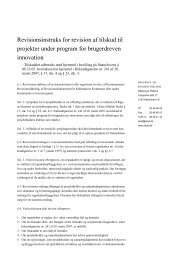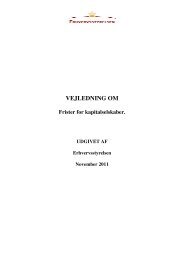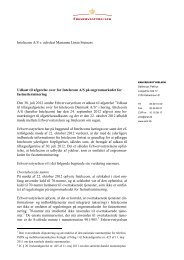Risk-Based Approach â Guidance for Money Service Businesses
Risk-Based Approach â Guidance for Money Service Businesses
Risk-Based Approach â Guidance for Money Service Businesses
Create successful ePaper yourself
Turn your PDF publications into a flip-book with our unique Google optimized e-Paper software.
<strong>Risk</strong>-<strong>Based</strong> <strong>Approach</strong> – <strong>Guidance</strong> <strong>for</strong> <strong>Money</strong> <strong>Service</strong> <strong>Businesses</strong> - July 2009 Chapter Two: The <strong>Risk</strong>-<strong>Based</strong> <strong>Approach</strong> – purpose, benefits and challengesThe purpose of the <strong>Risk</strong>-<strong>Based</strong> <strong>Approach</strong>14. The FATF Recommendations contain language that permits countries, in line with therequirements of the FATF Standards, to adopt a risk-based approach to combating money laundering andterrorist financing. That language also authorises countries to permit MSBs to use a risk-based approach todischarging certain of their anti-money laundering (AML) and counter-terrorist financing (CFT)obligations. By adopting a risk-based approach, competent authorities and MSBs are able to ensure thatmeasures to prevent or mitigate money laundering and terrorist financing are commensurate to the risksidentified. This will allow resources to be allocated in the most efficient ways. The principle is thatresources should be directed in accordance with priorities so that the greatest risks receive the highestattention. The alternative approaches are that resources are either applied evenly, so that all MSBs,customers, products, etc. receive equal attention, or that resources are targeted, but on the basis of factorsother than the risk assessed. This can inadvertently lead to a 'tick box' approach with the focus on meetingregulatory needs rather than combating money laundering or terrorist financing. Eventually, it is of utmostimportance that a risk based approach remains dynamic to risk; able to evolve to match a changed threat,and there<strong>for</strong>e flexible. MSBs should be able to show how their strategy and approach meet the changingthreats as identified by their own staff or external public sector parties.15. Adopting a risk-based approach implies the adoption of a risk management process <strong>for</strong> dealingwith money laundering and terrorist financing. This process encompasses recognising the existence of therisk(s), undertaking an assessment of the risk(s) and developing strategies to manage and mitigate theidentified risks.16. A risk analysis must be per<strong>for</strong>med, and kept up to date, to determine where the money launderingand terrorist financing risks are the greatest. Countries will need to identify the main vulnerabilities andaddress them accordingly. MSBs will need to identify higher risk customers, products and services,including delivery channels, and geographical locations. These are not static assessments. They willchange over time, depending on how circumstances develop, and how threats evolve.17. The strategies to manage and mitigate the identified money laundering and terrorist financingrisks in MSBs are typically aimed at preventing the activity from occurring through a mixture of deterrence(e.g. appropriate CDD measures in the circumstances stated in paragraph 48), detection (e.g. monitoringand suspicious transaction reporting), and record-keeping so as to facilitate investigations.18. Proportionate procedures should be designed based on assessed risk. Higher risk areas should besubject to enhanced measures <strong>for</strong> MSBs. This may include the measures mentioned in paragraph 116. Italso follows that in instances where risks are low, simplified or reduced controls may be applied.19. There are no universally accepted methodologies that prescribe the nature and extent of a riskbasedapproach. However, an effective risk-based approach does involve identifying and categorizingmoney laundering risks and establishing reasonable controls based on risks identified. An effective riskbasedapproach will allow MSBs to exercise reasonable business judgement with respect to theircustomers. Application of a reasoned and well-articulated risk-based approach will justify thedeterminations of MSBs with regard to managing potential money laundering and terrorist financing risksand allow MSBs to exercise reasonable business judgement with respect to their customers. A risk-basedapproach should not be designed to prohibit MSBs from engaging in transactions with customers or© 2009 FATF/OECD - 7
















